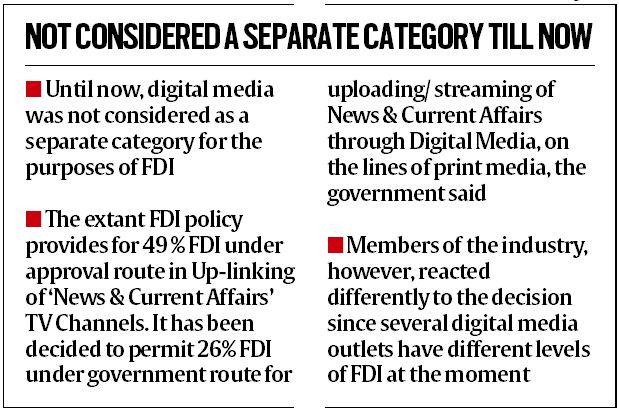Cabinet Decision: 26% FDI in digital news media creates confusion in the industry
Some digital media companies have 100 per cent FDI, while some others are restricted to 49 per cent.
 Until now, digital media was not considered as a separate category for the purposes of FDI.
Until now, digital media was not considered as a separate category for the purposes of FDI.
The government has created a new digital media category, distinct from print and broadcast media, and allowed 26 per cent foreign direct investment (FDI) through the government route. Until now, digital media was not considered as a separate category for the purposes of FDI.
Members of the industry, however, reacted differently to the decision since several digital media outlets have different levels of FDI at the moment. Some digital media companies have 100 per cent FDI, while some others are restricted to 49 per cent.
In a press statement after the decision was taken by the Cabinet, the government said: “The extant FDI policy provides for 49 per cent FDI under approval route in Up-linking of ‘News & Current Affairs’ TV Channels. It has been decided to permit 26 per cent FDI under government route for uploading/ streaming of News & Current Affairs through Digital Media, on the lines of print media.”
Some industry stakeholders feel this creates a new category for media companies — digital news and current affairs media — for which the FDI has been brought down to 26 per cent, at par with print media. Contrary to the general impression that FDI norms have been eased, some in the industry said, the move is actually “restrictive” as it limits FDI into a field which had none earlier.
However, some others feel it could bring clarity which can help the industry in the long run.
Unlike broadcast and print media, digital media has no entry barriers. To broadcast news in India, a broadcast media company needs a uplinking and/ or downlinking license; while newspapers or magazines need to register with the Registrar for the Newspapers of India (RNI), both of which fall under the Union Ministry for Information and Broadcasting.

But digital news media companies, which have websites or mobile apps, do not need any such registration. “Will they firewall anyone who is not in India,” a senior industry source asked. The source mentioned that websites of almost all global news platforms can be viewed in the country, even though their companies may not be registered here. Similarly, there are digital news platforms in the country, the source pointed out, which are headquartered outside the country. How will the government ensure all these digital news outlets are treated equally, the source said.
Another senior industry member, however, was more optimistic and said the move would bring much-needed clarity. The person said that “logically” it would mean that a company that “creates content and uploads it from India” will be allowed only 26 per cent FDI, while platforms that publish news, including websites or mobile applications could be based anywhere and read in India.
The person said that “if the intent is for big companies” to attract venture funding or strategic partners, it “will be good for everyone” as, the person said. The ambiguity at the moment could have made certain potential investors hesitant.
- 01
- 02
- 03
- 04
- 05































